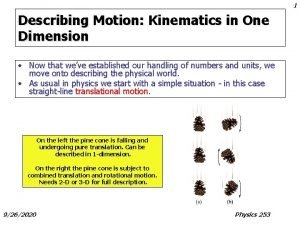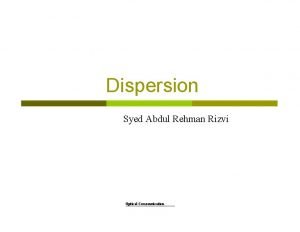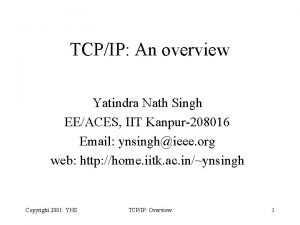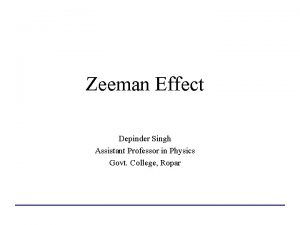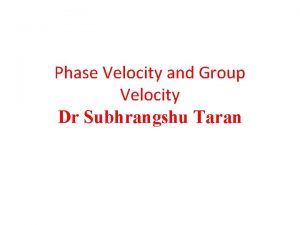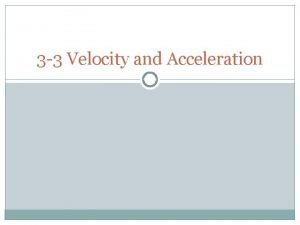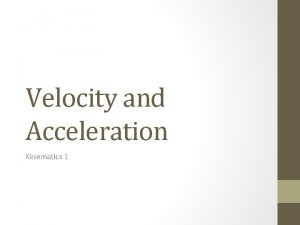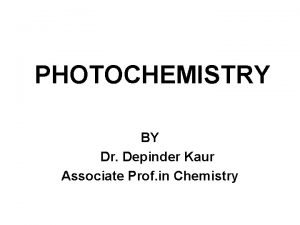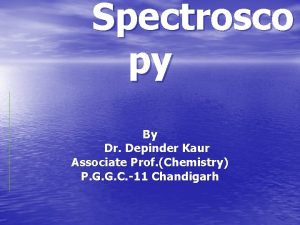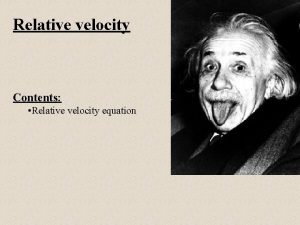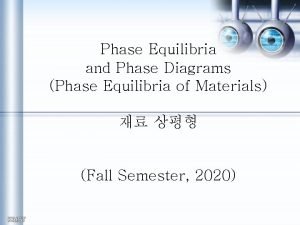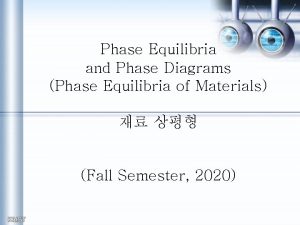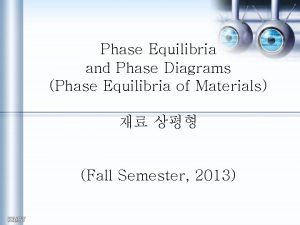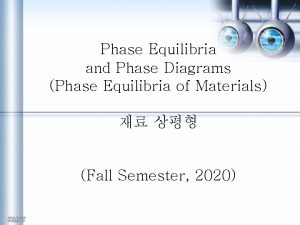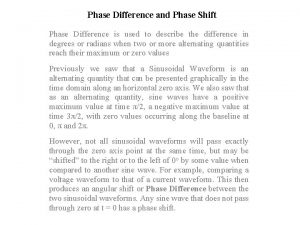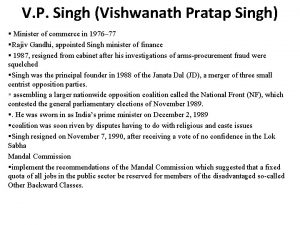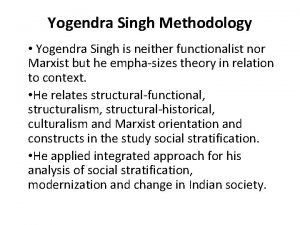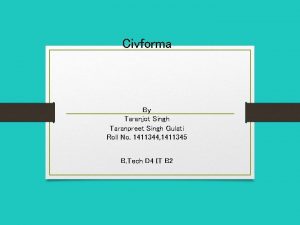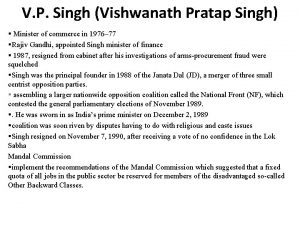Phase Velocity and Group Velocity Depinder Singh Assistant





































- Slides: 37

Phase Velocity and Group Velocity Depinder Singh Assistant Professor of Physics Govt. College Ropar

Particle _______________ Our traditional understanding of a particle… “Localized” - definite position, momentum, confined in space

Wave ______________ Our traditional understanding of a wave…. “de-localized” – spread out in space and time

Waves Normal Waves • are a disturbance in space • carry energy from one place to another • often (but not always) will (approximately) obey the classical wave equation Matter Waves • disturbance is the wave function Y(x, y, z, t ) – probability amplitude Y – probability density p(x, y, z, t ) =|Y|2

General Wave properties

How do we associate a wave nature to a particle? __________________ What could represent both wave and particle? Find a description of a particle which is consistent with our notion of both particles and waves…… • Fits the “wave” description • “Localized” in space

A “Wave Packet” __________________ How do you construct a wave packet?

What happens when you add up waves? ________________ The Superposition principle

Adding up waves of different frequencies. . . __________________

Constructing a wave packet by adding up several waves ………… __________________ If several waves of different wavelengths (frequencies) and phases are superposed together, one would get a resultant which is a localized wave packet

A wave packet describes a particle ______________ • A wave packet is a group of waves with slightly different wavelengths interfering with one another in a way that the amplitude of the group (envelope) is non-zero only in the neighbourhood of the particle • A wave packet is localized – a good representation for a particle!

Wave packet, phase velocity and group velocity ______________ • The spread of wave packet in wavelength depends on the required degree of localization in space – the central wavelength is given by • What is the velocity of the wave packet?

Wave packet, phase velocity and group velocity • The velocities of the individual waves which superpose to produce the wave packet representing the particle are different - the wave packet as a whole has a different velocity from the waves that comprise it • Phase velocity: The rate at which the phase of the wave propagates in space • Group velocity: The rate at which the envelope of the wave packet propagates

Phase velocity • Phase velocity is the rate at which the phase of the wave propagates in space. • This is the velocity at which the phase of any one frequency component of the wave will propagate. • You could pick one particular phase of the wave and it would appear to travel at the phase velocity. • The phase velocity is given in terms of the wave's angular frequency ω and wave vector k by

Group velocity of a wave is the velocity with which the variations in the shape of the wave's amplitude (known as the modulation or envelope of the wave) propagate through space. The group velocity is defined by the equation where: vg is the group velocity; ω is the wave's angular frequency; k is the wave number. The function ω(k), which gives ω as a function of k, is known as the dispersion relation.

Velocity of De-Broglie Waves-Phase velocity • Moving material particle-De broglie said a wave is associated which travel with the same velocity as that of the wave. • Let De-broglie wave velocity is W, so Vp or W=

Phase Velocity - continued • we know that =h/mv • From Planck`s Law E = h • From mass energy relation 2 E = mc 2

Phase Velocity - continued • h = mc 2/h W= Therefore • W= mc 2/h X h/mv W = C 2/v • So Particle velocity must be less than the velocity of light. W>c • We can say that De-Broglie waves must travel faster than the velocity of light.

Group Velocity=Particle velocity

Group Velocity=Particle velocity.

De Broglie waves for massive particles





Scheme

The group velocity is the velocity of a pulse of light, that is, of its irradiance. While we derived the group velocity using two frequencies, think of it as occurring at a given frequency, the center frequency of a pulsed wave. It’s the velocity of the pulse. When vg = vf, the pulse propagates at the same velocity as the carrier wave (i. e. , as the phase fronts): z This rarely occurs, however.

When the group and phase velocities are different… More generally, vg ≠ vf, and the carrier wave (phase fronts) propagates at the phase velocity, and the pulse (irradiance) propagates at the group velocity (usually slower). The carrier wave: The envelope (irradiance): Now we must multiply together these two quantities.

Differences in speed cause spreading or dispersion of wave packets

The group velocity is the speed of the wavepacket The phase velocity is the speed of the individual waves Phase velocity = Group Velocity The entire waveform—the component waves and their envelope—moves as one. non-dispersive wave. Phase velocity = -Group Velocity The envelope moves in the opposite direction of the component waves. Phase velocity > Group Velocity The component waves move more quickly than the envelope. Phase velocity < Group Velocity The component waves move more slowly than the envelope. Group Velocity = 0 The envelope is stationary while the component waves move through it. Phase velocity = 0 Now only the envelope moves over stationary component waves.

Relation Between Group Velocity and Phase Velocity


This gives us the relation between Phase velocity and Group velocity

This gives us the relation between Phase velocity and Group velocity

Thanks 35 Waves 11

Phase Velocity for a massive particle and massless Particle phase velocity does not describe particle motion 36 Waves 11

De Broglie Waves -Photons. 37 Waves 11
 Raj birk
Raj birk Mobile phase and stationary phase
Mobile phase and stationary phase Mobile phase in chromatography
Mobile phase in chromatography Detectors used in hplc
Detectors used in hplc Angular quantities and linear quantities cannot be related.
Angular quantities and linear quantities cannot be related. Initial velocity and final velocity formula
Initial velocity and final velocity formula Constant acceleration speed time graph
Constant acceleration speed time graph Normal phase vs reverse phase chromatography
Normal phase vs reverse phase chromatography M tswett pronunciation
M tswett pronunciation Normal phase vs reverse phase chromatography
Normal phase vs reverse phase chromatography Power formula three phase
Power formula three phase In a ∆-connected source feeding a y-connected load
In a ∆-connected source feeding a y-connected load Broad phase vs narrow phase
Broad phase vs narrow phase Darcy equation
Darcy equation Final velocity initial velocity acceleration time
Final velocity initial velocity acceleration time Instantaneous velocity vs average velocity
Instantaneous velocity vs average velocity Darcy velocity vs actual velocity
Darcy velocity vs actual velocity Angular velocity to tangential velocity
Angular velocity to tangential velocity The law of universal gravitation states that
The law of universal gravitation states that Scorer and assistant scorer
Scorer and assistant scorer Ending phase of group work
Ending phase of group work Material dispersion
Material dispersion Anova within group and between group
Anova within group and between group Classification of social group
Classification of social group Amino group and carboxyl group
Amino group and carboxyl group Amino group and carboxyl group
Amino group and carboxyl group Jrcptb patient survey
Jrcptb patient survey Joining together group theory and group skills
Joining together group theory and group skills Shopping for clothes dialogue
Shopping for clothes dialogue Conversation in a shop
Conversation in a shop Printing and dyeing assistant
Printing and dyeing assistant Ethical and legal issues affecting the nursing assistant
Ethical and legal issues affecting the nursing assistant The nursing assistant and the care team chapter 2
The nursing assistant and the care team chapter 2 Describe the care team and the chain of command
Describe the care team and the chain of command Sandeep singh jolly
Sandeep singh jolly Yatindra nath singh
Yatindra nath singh Singh song summary
Singh song summary Alankrita singh ips
Alankrita singh ips















